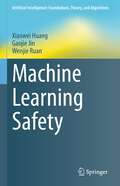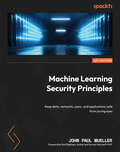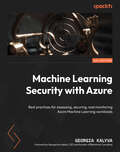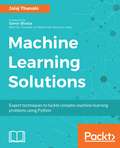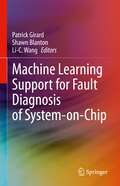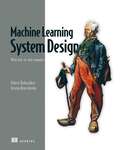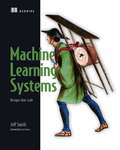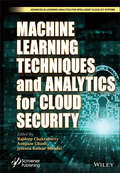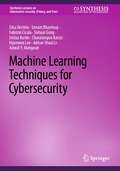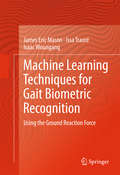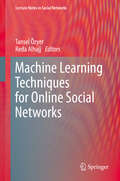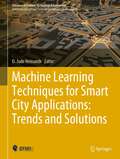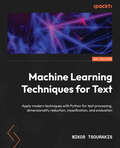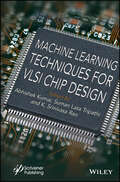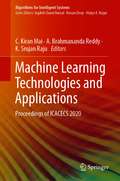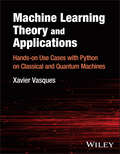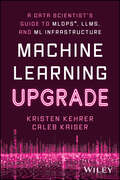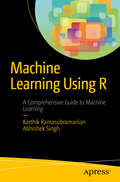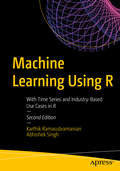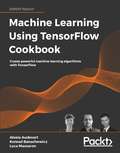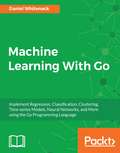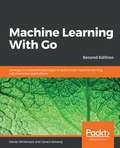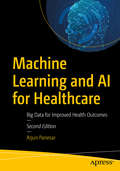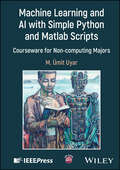- Table View
- List View
Machine Learning Safety (Artificial Intelligence: Foundations, Theory, and Algorithms)
by Xiaowei Huang Gaojie Jin Wenjie RuanMachine learning algorithms allow computers to learn without being explicitly programmed. Their application is now spreading to highly sophisticated tasks across multiple domains, such as medical diagnostics or fully autonomous vehicles. While this development holds great potential, it also raises new safety concerns, as machine learning has many specificities that make its behaviour prediction and assessment very different from that for explicitly programmed software systems. This book addresses the main safety concerns with regard to machine learning, including its susceptibility to environmental noise and adversarial attacks. Such vulnerabilities have become a major roadblock to the deployment of machine learning in safety-critical applications. The book presents up-to-date techniques for adversarial attacks, which are used to assess the vulnerabilities of machine learning models; formal verification, which is used to determine if a trained machine learning model is free of vulnerabilities; and adversarial training, which is used to enhance the training process and reduce vulnerabilities. The book aims to improve readers’ awareness of the potential safety issues regarding machine learning models. In addition, it includes up-to-date techniques for dealing with these issues, equipping readers with not only technical knowledge but also hands-on practical skills.
Machine Learning Security Principles: Keep data, networks, users, and applications safe from prying eyes
by John Paul Mueller Rod Stephens Alberto Di MeglioThwart hackers by preventing, detecting, and misdirecting access before they can plant malware, obtain credentials, engage in fraud, modify data, poison models, corrupt users, eavesdrop, and otherwise ruin your dayKey FeaturesDiscover how hackers rely on misdirection and deep fakes to fool even the best security systemsRetain the usefulness of your data by detecting unwanted and invalid modificationsDevelop application code to meet the security requirements related to machine learningBook DescriptionBusinesses are leveraging the power of AI to make undertakings that used to be complicated and pricy much easier, faster, and cheaper. The first part of this book will explore these processes in more depth, which will help you in understanding the role security plays in machine learning.As you progress to the second part, you'll learn more about the environments where ML is commonly used and dive into the security threats that plague them using code, graphics, and real-world references.The next part of the book will guide you through the process of detecting hacker behaviors in the modern computing environment, where fraud takes many forms in ML, from gaining sales through fake reviews to destroying an adversary's reputation. Once you've understood hacker goals and detection techniques, you'll learn about the ramifications of deep fakes, followed by mitigation strategies.This book also takes you through best practices for embracing ethical data sourcing, which reduces the security risk associated with data. You'll see how the simple act of removing personally identifiable information (PII) from a dataset lowers the risk of social engineering attacks.By the end of this machine learning book, you'll have an increased awareness of the various attacks and the techniques to secure your ML systems effectively.What you will learnExplore methods to detect and prevent illegal access to your systemImplement detection techniques when access does occurEmploy machine learning techniques to determine motivationsMitigate hacker access once security is breachedPerform statistical measurement and behavior analysisRepair damage to your data and applicationsUse ethical data collection methods to reduce security risksWho this book is forWhether you're a data scientist, researcher, or manager working with machine learning techniques in any aspect, this security book is a must-have. While most resources available on this topic are written in a language more suitable for experts, this guide presents security in an easy-to-understand way, employing a host of diagrams to explain concepts to visual learners. While familiarity with machine learning concepts is assumed, knowledge of Python and programming in general will be useful.
Machine Learning Security with Azure: Best practices for assessing, securing, and monitoring Azure Machine Learning workloads
by Georgia KalyvaImplement industry best practices to identify vulnerabilities and protect your data, models, environment, and applications while learning how to recover from a security breachKey FeaturesLearn about machine learning attacks and assess your workloads for vulnerabilitiesGain insights into securing data, infrastructure, and workloads effectivelyDiscover how to set and maintain a better security posture with the Azure Machine Learning platformPurchase of the print or Kindle book includes a free PDF eBookBook DescriptionWith AI and machine learning (ML) models gaining popularity and integrating into more and more applications, it is more important than ever to ensure that models perform accurately and are not vulnerable to cyberattacks. However, attacks can target your data or environment as well. This book will help you identify security risks and apply the best practices to protect your assets on multiple levels, from data and models to applications and infrastructure. This book begins by introducing what some common ML attacks are, how to identify your risks, and the industry standards and responsible AI principles you need to follow to gain an understanding of what you need to protect. Next, you will learn about the best practices to secure your assets. Starting with data protection and governance and then moving on to protect your infrastructure, you will gain insights into managing and securing your Azure ML workspace. This book introduces DevOps practices to automate your tasks securely and explains how to recover from ML attacks. Finally, you will learn how to set a security benchmark for your scenario and best practices to maintain and monitor your security posture. By the end of this book, you’ll be able to implement best practices to assess and secure your ML assets throughout the Azure Machine Learning life cycle.What you will learnExplore the Azure Machine Learning project life cycle and servicesAssess the vulnerability of your ML assets using the Zero Trust modelExplore essential controls to ensure data governance and compliance in AzureUnderstand different methods to secure your data, models, and infrastructure against attacksFind out how to detect and remediate past or ongoing attacksExplore methods to recover from a security breachMonitor and maintain your security posture with the right tools and best practicesWho this book is forThis book is for anyone looking to learn how to assess, secure, and monitor every aspect of AI or machine learning projects running on the Microsoft Azure platform using the latest security and compliance, industry best practices, and standards. This is a must-have resource for machine learning developers and data scientists working on ML projects. IT administrators, DevOps, and security engineers required to secure and monitor Azure workloads will also benefit from this book, as the chapters cover everything from implementation to deployment, AI attack prevention, and recovery.
Machine Learning Solutions: Expert techniques to tackle complex machine learning problems using Python
by Jalaj ThanakiPractical, hands-on solutions in Python to overcome any problem in Machine LearningKey FeaturesMaster the advanced concepts, methodologies, and use cases of machine learningBuild ML applications for analytics, NLP and computer vision domainsSolve the most common problems in building machine learning modelsBook DescriptionMachine learning (ML) helps you find hidden insights from your data without the need for explicit programming. This book is your key to solving any kind of ML problem you might come across in your job.You’ll encounter a set of simple to complex problems while building ML models, and you'll not only resolve these problems, but you’ll also learn how to build projects based on each problem, with a practical approach and easy-to-follow examples. The book includes a wide range of applications: from analytics and NLP, to computer vision domains. Some of the applications you will be working on include stock price prediction, a recommendation engine, building a chat-bot, a facial expression recognition system, and many more. The problem examples we cover include identifying the right algorithm for your dataset and use cases, creating and labeling datasets, getting enough clean data to carry out processing, identifying outliers, overftting datasets, hyperparameter tuning, and more. Here, you'll also learn to make more timely and accurate predictions.In addition, you'll deal with more advanced use cases, such as building a gaming bot, building an extractive summarization tool for medical documents, and you'll also tackle the problems faced while building an ML model. By the end of this book, you'll be able to fine-tune your models as per your needs to deliver maximum productivity.What you will learn Select the right algorithm to derive the best solution in ML domains Perform predictive analysis effciently using ML algorithms Predict stock prices using the stock index value Perform customer analytics for an e-commerce platform Build recommendation engines for various domains Build NLP applications for the health domain Build language generation applications using different NLP techniques Build computer vision applications such as facial emotion recognitionWho this book is forThis book is for the intermediate users such as machine learning engineers, data engineers, data scientists, and more, who want to solve simple to complex machine learning problems in their day-to-day work and build powerful and efficient machine learning models. A basic understanding of the machine learning concepts and some experience with Python programming is all you need to get started with this book.
Machine Learning Support for Fault Diagnosis of System-on-Chip
by Patrick Girard Shawn Blanton Li-C. WangThis book provides a state-of-the-art guide to Machine Learning (ML)-based techniques that have been shown to be highly efficient for diagnosis of failures in electronic circuits and systems. The methods discussed can be used for volume diagnosis after manufacturing or for diagnosis of customer returns. Readers will be enabled to deal with huge amount of insightful test data that cannot be exploited otherwise in an efficient, timely manner. After some background on fault diagnosis and machine learning, the authors explain and apply optimized techniques from the ML domain to solve the fault diagnosis problem in the realm of electronic system design and manufacturing. These techniques can be used for failure isolation in logic or analog circuits, board-level fault diagnosis, or even wafer-level failure cluster identification. Evaluation metrics as well as industrial case studies are used to emphasize the usefulness and benefits of using ML-based diagnosis techniques.
Machine Learning System Design: With end-to-end examples
by Valerii Babuskhin Arseny KravchenkoGet the big picture and the important details with this end-to-end guide for designing highly effective, reliable machine learning systems.From information gathering to release and maintenance, Machine Learning System Design guides you step-by-step through every stage of the machine learning process. Inside, you&’ll find a reliable framework for building, maintaining, and improving machine learning systems at any scale or complexity. In Machine Learning System Design: With end-to-end examples you will learn: • The big picture of machine learning system design • Analyzing a problem space to identify the optimal ML solution • Ace ML system design interviews • Selecting appropriate metrics and evaluation criteria • Prioritizing tasks at different stages of ML system design • Solving dataset-related problems with data gathering, error analysis, and feature engineering • Recognizing common pitfalls in ML system development • Designing ML systems to be lean, maintainable, and extensible over time Authors Valeri Babushkin and Arseny Kravchenko have filled this unique handbook with campfire stories and personal tips from their own extensive careers. You&’ll learn directly from their experience as you consider every facet of a machine learning system, from requirements gathering and data sourcing to deployment and management of the finished system. About the technology Designing and delivering a machine learning system is an intricate multistep process that requires many skills and roles. Whether you&’re an engineer adding machine learning to an existing application or designing a ML system from the ground up, you need to navigate massive datasets and streams, lock down testing and deployment requirements, and master the unique complexities of putting ML models into production. That&’s where this book comes in. About the book Machine Learning System Design shows you how to design and deploy a machine learning project from start to finish. You&’ll follow a step-by-step framework for designing, implementing, releasing, and maintaining ML systems. As you go, requirement checklists and real-world examples help you prepare to deliver and optimize your own ML systems. You&’ll especially love the campfire stories and personal tips, and ML system design interview tips. What's inside • Metrics and evaluation criteria • Solve common dataset problems • Common pitfalls in ML system development • ML system design interview tips About the reader For readers who know the basics of software engineering and machine learning. Examples in Python. About the author Valerii Babushkin is an accomplished data science leader with extensive experience. He currently serves as a Senior Principal at BP. Arseny Kravchenko is a seasoned ML engineer currently working as a Senior Staff Machine Learning Engineer at Instrumental. Table of Contents Part 1 1 Essentials of machine learning system design 2 Is there a problem? 3 Preliminary research 4 Design document Part 2 5 Loss functions and metrics 6 Gathering datasets 7 Validation schemas 8 Baseline solution Part 3 9 Error analysis 10 Training pipelines 11 Features and feature engineering 12 Measuring and reporting results Part 4 13 Integration 14 Monitoring and reliability 15 Serving and inference optimization 16 Ownership and maintenance
Machine Learning Systems: Designs that scale
by Jeffrey SmithSummary Machine Learning Systems: Designs that scale is an example-rich guide that teaches you how to implement reactive design solutions in your machine learning systems to make them as reliable as a well-built web app. Foreword by Sean Owen, Director of Data Science, Cloudera Purchase of the print book includes a free eBook in PDF, Kindle, and ePub formats from Manning Publications. About the Technology If you&’re building machine learning models to be used on a small scale, you don't need this book. But if you're a developer building a production-grade ML application that needs quick response times, reliability, and good user experience, this is the book for you. It collects principles and practices of machine learning systems that are dramatically easier to run and maintain, and that are reliably better for users. About the Book Machine Learning Systems: Designs that scale teaches you to design and implement production-ready ML systems. You'll learn the principles of reactive design as you build pipelines with Spark, create highly scalable services with Akka, and use powerful machine learning libraries like MLib on massive datasets. The examples use the Scala language, but the same ideas and tools work in Java, as well. What's Inside Working with Spark, MLlib, and Akka Reactive design patterns Monitoring and maintaining a large-scale system Futures, actors, and supervision About the Reader Readers need intermediate skills in Java or Scala. No prior machine learning experience is assumed. About the Author Jeff Smith builds powerful machine learning systems. For the past decade, he has been working on building data science applications, teams, and companies as part of various teams in New York, San Francisco, and Hong Kong. He blogs (https: //medium.com/@jeffksmithjr), tweets (@jeffksmithjr), and speaks (www.jeffsmith.tech/speaking) about various aspects of building real-world machine learning systems. Table of Contents PART 1 - FUNDAMENTALS OF REACTIVE MACHINE LEARNING Learning reactive machine learning Using reactive tools PART 2 - BUILDING A REACTIVE MACHINE LEARNING SYSTEM Collecting data Generating features Learning models Evaluating models Publishing models Responding PART 3 - OPERATING A MACHINE LEARNING SYSTEM Delivering Evolving intelligence
Machine Learning Techniques and Analytics for Cloud Security (Advances in Learning Analytics for Intelligent Cloud-IoT Systems)
by Jyotsna Kumar Mandal Rajdeep Chakraborty Anupam GhoshMACHINE LEARNING TECHNIQUES AND ANALYTICS FOR CLOUD SECURITY This book covers new methods, surveys, case studies, and policy with almost all machine learning techniques and analytics for cloud security solutions The aim of Machine Learning Techniques and Analytics for Cloud Security is to integrate machine learning approaches to meet various analytical issues in cloud security. Cloud security with ML has long-standing challenges that require methodological and theoretical handling. The conventional cryptography approach is less applied in resource-constrained devices. To solve these issues, the machine learning approach may be effectively used in providing security to the vast growing cloud environment. Machine learning algorithms can also be used to meet various cloud security issues, such as effective intrusion detection systems, zero-knowledge authentication systems, measures for passive attacks, protocols design, privacy system designs, applications, and many more. The book also contains case studies/projects outlining how to implement various security features using machine learning algorithms and analytics on existing cloud-based products in public, private and hybrid cloud respectively. Audience Research scholars and industry engineers in computer sciences, electrical and electronics engineering, machine learning, computer security, information technology, and cryptography.
Machine Learning Techniques for Cybersecurity (Synthesis Lectures on Information Security, Privacy, and Trust)
by Elisa Bertino Sonam Bhardwaj Fabrizio Cicala Sishuai Gong Imtiaz Karim Charalampos Katsis Hyunwoo Lee Adrian Shuai Li Ashraf Y. MahgoubThis book explores machine learning (ML) defenses against the many cyberattacks that make our workplaces, schools, private residences, and critical infrastructures vulnerable as a consequence of the dramatic increase in botnets, data ransom, system and network denials of service, sabotage, and data theft attacks. The use of ML techniques for security tasks has been steadily increasing in research and also in practice over the last 10 years. Covering efforts to devise more effective defenses, the book explores security solutions that leverage machine learning (ML) techniques that have recently grown in feasibility thanks to significant advances in ML combined with big data collection and analysis capabilities. Since the use of ML entails understanding which techniques can be best used for specific tasks to ensure comprehensive security, the book provides an overview of the current state of the art of ML techniques for security and a detailed taxonomy of security tasks and corresponding ML techniques that can be used for each task. It also covers challenges for the use of ML for security tasks and outlines research directions. While many recent papers have proposed approaches for specific tasks, such as software security analysis and anomaly detection, these approaches differ in many aspects, such as with respect to the types of features in the model and the dataset used for training the models. In a way that no other available work does, this book provides readers with a comprehensive view of the complex area of ML for security, explains its challenges, and highlights areas for future research. This book is relevant to graduate students in computer science and engineering as well as information systems studies, and will also be useful to researchers and practitioners who work in the area of ML techniques for security tasks.
Machine Learning Techniques for Gait Biometric Recognition
by Isaac Woungang James Eric Mason Issa TraoréThis book focuses on how machine learning techniques can be used to analyze and make use of one particular category of behavioral biometrics known as the gait biometric. A comprehensive Ground Reaction Force (GRF)-based Gait Biometrics Recognition framework is proposed and validated by experiments. In addition, an in-depth analysis of existing recognition techniques that are best suited for performing footstep GRF-based person recognition is also proposed, as well as a comparison of feature extractors, normalizers, and classifiers configurations that were never directly compared with one another in any previous GRF recognition research. Finally, a detailed theoretical overview of many existing machine learning techniques is presented, leading to a proposal of two novel data processing techniques developed specifically for the purpose of gait biometric recognition using GRF. This book · introduces novel machine-learning-based temporal normalization techniques · bridges research gaps concerning the effect of footwear and stepping speed on footstep GRF-based person recognition · provides detailed discussions of key research challenges and open research issues in gait biometrics recognition · compares biometrics systems trained and tested with the same footwear against those trained and tested with different footwear
Machine Learning Techniques for Online Social Networks (Lecture Notes In Social Networks Ser.)
by Tansel Özyer Reda AlhajjThe book covers tools in the study of online social networks such as machine learning techniques, clustering, and deep learning. A variety of theoretical aspects, application domains, and case studies for analyzing social network data are covered. The aim is to provide new perspectives on utilizing machine learning and related scientific methods and techniques for social network analysis. Machine Learning Techniques for Online Social Networks will appeal to researchers and students in these fields.
Machine Learning Techniques for Smart City Applications: Trends and Solutions (Advances in Science, Technology & Innovation)
by D. Jude HemanthThis book discusses the application of different machine learning techniques to the sub-concepts of smart cities such as smart energy, transportation, waste management, health, infrastructure, etc. The focus of this book is to come up with innovative solutions in the above-mentioned issues with the purpose of alleviating the pressing needs of human society. This book includes content with practical examples which are easy to understand for readers. It also covers a multi-disciplinary field and, consequently, it benefits a wide readership including academics, researchers, and practitioners.
Machine Learning Techniques for Text: Apply modern techniques with Python for text processing, dimensionality reduction, classification, and evaluation
by Nikos TsourakisTake your Python text processing skills to another level by learning about the latest natural language processing and machine learning techniques with this full color guideKey FeaturesLearn how to acquire and process textual data and visualize the key findingsObtain deeper insight into the most commonly used algorithms and techniques and understand their tradeoffsImplement models for solving real-world problems and evaluate their performanceBook DescriptionWith the ever-increasing demand for machine learning and programming professionals, it's prime time to invest in the field. This book will help you in this endeavor, focusing specifically on text data and human language by steering a middle path among the various textbooks that present complicated theoretical concepts or focus disproportionately on Python code.A good metaphor this work builds upon is the relationship between an experienced craftsperson and their trainee. Based on the current problem, the former picks a tool from the toolbox, explains its utility, and puts it into action. This approach will help you to identify at least one practical use for each method or technique presented. The content unfolds in ten chapters, each discussing one specific case study. For this reason, the book is solution-oriented. It's accompanied by Python code in the form of Jupyter notebooks to help you obtain hands-on experience. A recurring pattern in the chapters of this book is helping you get some intuition on the data and then implement and contrast various solutions.By the end of this book, you'll be able to understand and apply various techniques with Python for text preprocessing, text representation, dimensionality reduction, machine learning, language modeling, visualization, and evaluation.What you will learnUnderstand fundamental concepts of machine learning for textDiscover how text data can be represented and build language modelsPerform exploratory data analysis on text corporaUse text preprocessing techniques and understand their trade-offsApply dimensionality reduction for visualization and classificationIncorporate and fine-tune algorithms and models for machine learningEvaluate the performance of the implemented systemsKnow the tools for retrieving text data and visualizing the machine learning workflowWho this book is forThis book is for professionals in the area of computer science, programming, data science, informatics, business analytics, statistics, language technology, and more who aim for a gentle career shift in machine learning for text. Students in relevant disciplines that seek a textbook in the field will benefit from the practical aspects of the content and how the theory is presented. Finally, professors teaching a similar course will be able to pick pertinent topics in terms of content and difficulty. Beginner-level knowledge of Python programming is needed to get started with this book.
Machine Learning Techniques for VLSI Chip Design
by Abhishek Kumar Suman Lata Tripathi K. Srinivasa RaoMACHINE LEARNING TECHNIQUES FOR VLSI CHIP DESIGN This cutting-edge new volume covers the hardware architecture implementation, the software implementation approach, the efficient hardware of machine learning applications with FPGA or CMOS circuits, and many other aspects and applications of machine learning techniques for VLSI chip design. Artificial intelligence (AI) and machine learning (ML) have, or will have, an impact on almost every aspect of our lives and every device that we own. AI has benefitted every industry in terms of computational speeds, accurate decision prediction, efficient machine learning (ML), and deep learning (DL) algorithms. The VLSI industry uses the electronic design automation tool (EDA), and the integration with ML helps in reducing design time and cost of production. Finding defects, bugs, and hardware Trojans in the design with ML or DL can save losses during production. Constraints to ML-DL arise when having to deal with a large set of training datasets. This book covers the learning algorithm for floor planning, routing, mask fabrication, and implementation of the computational architecture for ML-DL. The future aspect of the ML-DL algorithm is to be available in the format of an integrated circuit (IC). A user can upgrade to the new algorithm by replacing an IC. This new book mainly deals with the adaption of computation blocks like hardware accelerators and novel nano-material for them based upon their application and to create a smart solution. This exciting new volume is an invaluable reference for beginners as well as engineers, scientists, researchers, and other professionals working in the area of VLSI architecture development.
Machine Learning Technologies and Applications: Proceedings of ICACECS 2020 (Algorithms for Intelligent Systems)
by K. Srujan Raju C. Kiran Mai A. Brahmananda ReddyThis book comprises the best deliberations with the theme “Machine Learning Technologies and Applications” in the “International Conference on Advances in Computer Engineering and Communication Systems (ICACECS 2020),” organized by the Department of Computer Science and Engineering, VNR Vignana Jyothi Institute of Engineering and Technology. The book provides insights into the recent trends and developments in the field of computer science with a special focus on the machine learning and big data. The book focuses on advanced topics in artificial intelligence, machine learning, data mining and big data computing, cloud computing, Internet of things, distributed computing and smart systems.
Machine Learning Theory and Applications: Hands-on Use Cases with Python on Classical and Quantum Machines
by Xavier VasquesMachine Learning Theory and Applications Enables readers to understand mathematical concepts behind data engineering and machine learning algorithms and apply them using open-source Python libraries Machine Learning Theory and Applications delves into the realm of machine learning and deep learning, exploring their practical applications by comprehending mathematical concepts and implementing them in real-world scenarios using Python and renowned open-source libraries. This comprehensive guide covers a wide range of topics, including data preparation, feature engineering techniques, commonly utilized machine learning algorithms like support vector machines and neural networks, as well as generative AI and foundation models. To facilitate the creation of machine learning pipelines, a dedicated open-source framework named hephAIstos has been developed exclusively for this book. Moreover, the text explores the fascinating domain of quantum machine learning and offers insights on executing machine learning applications across diverse hardware technologies such as CPUs, GPUs, and QPUs. Finally, the book explains how to deploy trained models through containerized applications using Kubernetes and OpenShift, as well as their integration through machine learning operations (MLOps). Additional topics covered in Machine Learning Theory and Applications include: Current use cases of AI, including making predictions, recognizing images and speech, performing medical diagnoses, creating intelligent supply chains, natural language processing, and much more Classical and quantum machine learning algorithms such as quantum-enhanced Support Vector Machines (QSVMs), QSVM multiclass classification, quantum neural networks, and quantum generative adversarial networks (qGANs) Different ways to manipulate data, such as handling missing data, analyzing categorical data, or processing time-related data Feature rescaling, extraction, and selection, and how to put your trained models to life and production through containerized applications Machine Learning Theory and Applications is an essential resource for data scientists, engineers, and IT specialists and architects, as well as students in computer science, mathematics, and bioinformatics. The reader is expected to understand basic Python programming and libraries such as NumPy or Pandas and basic mathematical concepts, especially linear algebra.
Machine Learning Upgrade: A Data Scientist's Guide to MLOps, LLMs, and ML Infrastructure
by Kristen Kehrer Caleb KaiserA much-needed guide to implementing new technology in workspaces From experts in the field comes Machine Learning Upgrade: A Data Scientist's Guide to MLOps, LLMs, and ML Infrastructure, a book that provides data scientists and managers with best practices at the intersection of management, large language models (LLMs), machine learning, and data science. This groundbreaking book will change the way that you view the pipeline of data science. The authors provide an introduction to modern machine learning, showing you how it can be viewed as a holistic, end-to-end system—not just shiny new gadget in an otherwise unchanged operational structure. By adopting a data-centric view of the world, you can begin to see unstructured data and LLMs as the foundation upon which you can build countless applications and business solutions. This book explores a whole world of decision making that hasn't been codified yet, enabling you to forge the future using emerging best practices. Gain an understanding of the intersection between large language models and unstructured data Follow the process of building an LLM-powered application while leveraging MLOps techniques such as data versioning and experiment tracking Discover best practices for training, fine tuning, and evaluating LLMs Integrate LLM applications within larger systems, monitor their performance, and retrain them on new data This book is indispensable for data professionals and business leaders looking to understand LLMs and the entire data science pipeline.
Machine Learning Using R
by Karthik Ramasubramanian Abhishek SinghExamine the latest technological advancements in building a scalable machine learning model with Big Data using R. This book shows you how to work with a machine learning algorithm and use it to build a ML model from raw data. All practical demonstrations will be explored in R, a powerful programming language and software environment for statistical computing and graphics. The various packages and methods available in R will be used to explain the topics. For every machine learning algorithm covered in this book, a 3-D approach of theory, case-study and practice will be given. And where appropriate, the mathematics will be explained through visualization in R. All the images are available in color and hi-res as part of the code download. This new paradigm of teaching machine learning will bring about a radical change in perception for many of those who think this subject is difficult to learn. Though theory sometimes looks difficult, especially when there is heavy mathematics involved, the seamless flow from the theoretical aspects to example-driven learning provided in this book makes it easy for someone to connect the dots. . What You'll Learn Use the model building process flow Apply theoretical aspects of machine learning Review industry-based cae studies Understand ML algorithms using R Build machine learning models using Apache Hadoop and Spark Who This Book is For Data scientists, data science professionals and researchers in academia who want to understand the nuances of machine learning approaches/algorithms along with ways to see them in practice using R. The book will also benefit the readers who want to understand the technology behind implementing a scalable machine learning model using Apache Hadoop, Hive, Pig and Spark.
Machine Learning Using R
by Karthik Ramasubramanian Abhishek SinghExamine the latest technological advancements in building a scalable machine-learning model with big data using R. This second edition shows you how to work with a machine-learning algorithm and use it to build a ML model from raw data. You will see how to use R programming with TensorFlow, thus avoiding the effort of learning Python if you are only comfortable with R.As in the first edition, the authors have kept the fine balance of theory and application of machine learning through various real-world use-cases which gives you a comprehensive collection of topics in machine learning. New chapters in this edition cover time series models and deep learning.What You'll Learn Understand machine learning algorithms using RMaster the process of building machine-learning models Cover the theoretical foundations of machine-learning algorithmsSee industry focused real-world use casesTackle time series modeling in RApply deep learning using Keras and TensorFlow in RWho This Book is ForData scientists, data science professionals, and researchers in academia who want to understand the nuances of machine-learning approaches/algorithms in practice using R.
Machine Learning Using TensorFlow Cookbook: Over 60 recipes on machine learning using deep learning solutions from Kaggle Masters and Google Developer Experts
by Luca Massaron Alexia Audevart Konrad BanachewiczMaster TensorFlow to create powerful machine learning algorithms, with valuable insights on Keras, Boosted Trees, Tabular Data, Transformers, Reinforcement Learning and moreKey FeaturesWork with the latest code and examples for TensorFlow 2Get to grips with the fundamentals including variables, matrices, and data sourcesLearn advanced deep learning techniques to make your algorithms faster and more accurateBook DescriptionThe independent recipes in Machine Learning Using TensorFlow Cookbook will teach you how to perform complex data computations and gain valuable insights into your data. You will work through recipes on training models, model evaluation, sentiment analysis, regression analysis, artificial neural networks, and deep learning - each using Google's machine learning library, TensorFlow. This cookbook begins by introducing you to the fundamentals of the TensorFlow library, including variables, matrices, and various data sources. You'll then take a deep dive into some real-world implementations of Keras and TensorFlow and learn how to use estimators to train linear models and boosted trees, both for classification and for regression to provide a baseline for tabular data problems. As you progress, you'll explore the practical applications of a variety of deep learning architectures, such as recurrent neural networks and Transformers, and see how they can be applied to computer vision and natural language processing (NLP) problems. Once you are familiar with the TensorFlow ecosystem, the final chapter will teach you how to take a project to production. By the end of this machine learning book, you will be proficient in using TensorFlow 2. You'll also understand deep learning from the fundamentals and be able to implement machine learning algorithms in real-world scenarios.What you will learnGrasp linear regression techniques with TensorFlowUse Estimators to train linear models and boosted trees for classification or regressionExecute neural networks and improve predictions on tabular dataMaster convolutional neural networks and recurrent neural networks through practical recipesApply reinforcement learning algorithms using the TF-Agents frameworkImplement and fine-tune Transformer models for various NLP tasksTake TensorFlow into productionWho this book is forIf you are a data scientist or a machine learning engineer, and you want to skip detailed theoretical explanations in favor of building production-ready machine learning models using TensorFlow, this book is for you.Basic familiarity with Python, linear algebra, statistics, and machine learning is necessary to make the most out of this book.
Machine Learning With Go
by Daniel WhitenackBuild simple, maintainable, and easy to deploy machine learning applications. About This Book • Build simple, but powerful, machine learning applications that leverage Go's standard library along with popular Go packages. • Learn the statistics, algorithms, and techniques needed to successfully implement machine learning in Go • Understand when and how to integrate certain types of machine learning model in Go applications. Who This Book Is For This book is for Go developers who are familiar with the Go syntax and can develop, build, and run basic Go programs. If you want to explore the field of machine learning and you love Go, then this book is for you! Machine Learning with Go will give readers the practical skills to perform the most common machine learning tasks with Go. Familiarity with some statistics and math topics is necessary. What You Will Learn • Learn about data gathering, organization, parsing, and cleaning. • Explore matrices, linear algebra, statistics, and probability. • See how to evaluate and validate models. • Look at regression, classification, clustering. • Learn about neural networks and deep learning • Utilize times series models and anomaly detection. • Get to grip with techniques for deploying and distributing analyses and models. • Optimize machine learning workflow techniques In Detail The mission of this book is to turn readers into productive, innovative data analysts who leverage Go to build robust and valuable applications. To this end, the book clearly introduces the technical aspects of building predictive models in Go, but it also helps the reader understand how machine learning workflows are being applied in real-world scenarios. Machine Learning with Go shows readers how to be productive in machine learning while also producing applications that maintain a high level of integrity. It also gives readers patterns to overcome challenges that are often encountered when trying to integrate machine learning in an engineering organization. The readers will begin by gaining a solid understanding of how to gather, organize, and parse real-work data from a variety of sources. Readers will then develop a solid statistical toolkit that will allow them to quickly understand gain intuition about the content of a dataset. Finally, the readers will gain hands-on experience implementing essential machine learning techniques (regression, classification, clustering, and so on) with the relevant Go packages. Finally, the reader will have a solid machine learning mindset and a powerful Go toolkit of techniques, packages, and example implementations. Style and approach This book connects the fundamental, theoretical concepts behind Machine Learning to practical implementations using the Go programming language.
Machine Learning With Go: Leverage Go's powerful packages to build smart machine learning and predictive applications, 2nd Edition
by Daniel Whitenack Janani SelvarajInfuse an extra layer of intelligence into your Go applications with machine learning and AIKey FeaturesBuild simple, maintainable, and easy to deploy machine learning applications with popular Go packagesLearn the statistics, algorithms, and techniques to implement machine learningOvercome the common challenges faced while deploying and scaling the machine learning workflowsBook DescriptionThis updated edition of the popular Machine Learning With Go shows you how to overcome the common challenges of integrating analysis and machine learning code within an existing engineering organization.Machine Learning With Go, Second Edition, will begin by helping you gain an understanding of how to gather, organize, and parse real-world data from a variety of sources. The book also provides absolute coverage in developing groundbreaking machine learning pipelines including predictive models, data visualizations, and statistical techniques. Up next, you will learn the thorough utilization of Golang libraries including golearn, gorgonia, gosl, hector, and mat64. You will discover the various TensorFlow capabilities, along with building simple neural networks and integrating them into machine learning models. You will also gain hands-on experience implementing essential machine learning techniques such as regression, classification, and clustering with the relevant Go packages. Furthermore, you will deep dive into the various Go tools that help you build deep neural networks. Lastly, you will become well versed with best practices for machine learning model tuning and optimization.By the end of the book, you will have a solid machine learning mindset and a powerful Go toolkit of techniques, packages, and example implementationsWhat you will learnBecome well versed with data processing, parsing, and cleaning using Go packagesLearn to gather data from various sources and in various real-world formatsPerform regression, classification, and image processing with neural networksEvaluate and detect anomalies in a time series modelUnderstand common deep learning architectures to learn how each model is builtLearn how to optimize, build, and scale machine learning workflowsDiscover the best practices for machine learning model tuning for successful deploymentsWho this book is forThis book is primarily for Go programmers who want to become a machine learning engineer and to build a solid machine learning mindset along with a good hold on Go packages. This is also useful for data analysts, data engineers, machine learning users who want to run their machine learning experiments using the Go ecosystem. Prior understanding of linear algebra is required to benefit from this book
Machine Learning and AI for Healthcare: Big Data for Improved Health Outcomes
by Arjun PanesarThis updated second edition offers a guided tour of machine learning algorithms and architecture design. It provides real-world applications of intelligent systems in healthcare and covers the challenges of managing big data.The book has been updated with the latest research in massive data, machine learning, and AI ethics. It covers new topics in managing the complexities of massive data, and provides examples of complex machine learning models. Updated case studies from global healthcare providers showcase the use of big data and AI in the fight against chronic and novel diseases, including COVID-19. The ethical implications of digital healthcare, analytics, and the future of AI in population health management are explored. You will learn how to create a machine learning model, evaluate its performance, and operationalize its outcomes within your organization. Case studies from leading healthcare providers cover scaling global digital services. Techniques are presented to evaluate the efficacy, suitability, and efficiency of AI machine learning applications through case studies and best practice, including the Internet of Things.You will understand how machine learning can be used to develop health intelligence–with the aim of improving patient health, population health, and facilitating significant care-payer cost savings.What You Will LearnUnderstand key machine learning algorithms and their use and implementation within healthcareImplement machine learning systems, such as speech recognition and enhanced deep learning/AIManage the complexities of massive dataBe familiar with AI and healthcare best practices, feedback loops, and intelligent agentsWho This Book Is ForHealth care professionals interested in how machine learning can be used to develop health intelligence – with the aim of improving patient health, population health and facilitating significant care-payer cost savings.
Machine Learning and AI with Simple Python and Matlab Scripts: Courseware for Non-computing Majors (IEEE Press)
by M. Umit UyarA practical guide to AI applications for Simple Python and Matlab scripts Machine Learning and AI with Simple Python and Matlab Scripts: Courseware for Non-computing Majors introduces basic concepts and principles of machine learning and artificial intelligence to help readers develop skills applicable to many popular topics in engineering and science. Step-by-step instructions for simple Python and Matlab scripts mimicking real-life applications will enter the readers into the magical world of AI, without requiring them to have advanced math and computational skills. The book is supported by instructor only lecture slides and sample exams with multiple-choice questions. Machine Learning and AI with Simple Python and Matlab Scripts includes information on: Artificial neural networks applied to real-world problems such as algorithmic trading of financial assets, Alzheimer’s disease prognosisConvolution neural networks for speech recognition and optical character recognitionRecurrent neural networks for chatbots and natural language translatorsTypical AI tasks including flight control for autonomous drones, dietary menu planning, and route planningAdvanced AI tasks including particle swarm optimization and differential and grammatical evolution as well as the current state of the art in AI tools Machine Learning and AI with Simple Python and Matlab Scripts is an accessible, thorough, and practical learning resource for undergraduate and graduate students in engineering and science programs along with professionals in related industries seeking to expand their skill sets.
Machine Learning and Analytics in Healthcare Systems: Principles and Applications (Green Engineering and Technology)
by Himani Bansal, Balamurugan Balusamy, T. Poongodi, and Firoz Khan KPThis book provides applications of machine learning in healthcare systems and seeks to close the gap between engineering and medicine. It will combine the design and problem-solving skills of engineering with health sciences, in order to advance healthcare treatment. The book will include areas such as diagnosis, monitoring, and therapy. The book will provide real-world case studies, gives a detailed exploration of applications in healthcare systems, offers multiple perspectives on a variety of disciplines, while also letting the reader know how to avoid some of the consequences of old methods with data sharing. The book can be used as a reference for practitioners, researchers and for students at basic and intermediary levels in Computer Science, Electronics and Communications.
